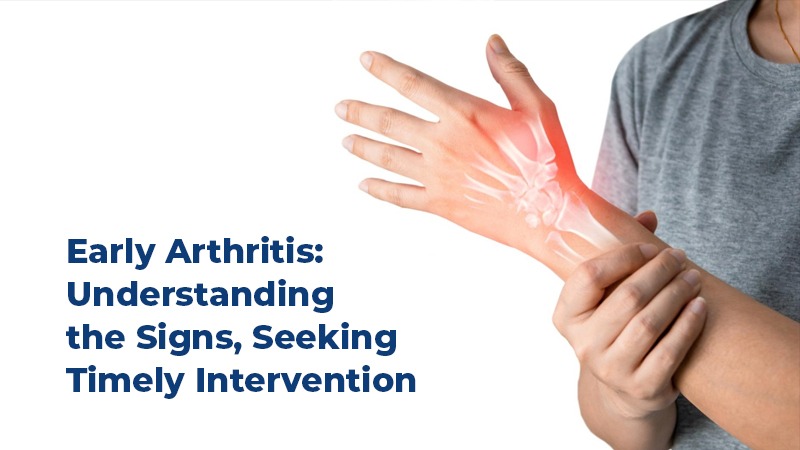Early Arthritis: Understanding the Signs, Seeking Timely Intervention
Arthritis is a prevalent condition affecting millions worldwide, with various forms and presentations. Among them, early arthritis poses a unique challenge, as it often goes unnoticed or is mistaken for minor joint discomfort. However, recognizing the signs and seeking timely medical intervention at Bangalore’s Best Hospital for Orthopaedics, Trustwell Institute of Musculoskeletal Skeletal Sciences can significantly impact long-term outcomes. In this blog post, we will delve into the world of early arthritis, exploring its symptoms, risk factors, and the importance of early diagnosis and treatment.
What is Early Arthritis?
Early arthritis refers to the initial stages of joint inflammation and damage, often preceding the more severe forms of arthritis such as rheumatoid arthritis (RA) or osteoarthritis (OA). Unlike the visible joint deformities and chronic pain associated with advanced arthritis, early arthritis may manifest as subtle symptoms that are easily disregarded.
Symptoms of Early Arthritis
Symptoms of early arthritis vary depending on the type but often include joint stiffness, pain, swelling, and reduced range of motion. It may also present Fatigue and a general feeling of malaise. These symptoms may come and go, misleading individuals to dismiss them as temporary or age-related discomfort. However, it is crucial to pay attention to the persistence or recurrence of these symptoms, as they may indicate an underlying inflammatory condition.
Risk Factors for Early Arthritis
While the exact causes of early arthritis remain unclear, several factors increase the risk of developing the condition. These include a family history of arthritis, age (as certain types tend to affect specific age groups), gender (as some types are more prevalent in women), obesity, previous joint injuries, and occupations involving repetitive joint stress. Furthermore, certain autoimmune diseases, such as lupus or psoriasis, can increase the likelihood of developing arthritis.
The Crucial Role of Early Diagnosis and Treatment
Early diagnosis and treatment play a pivotal role in managing arthritis effectively. When left untreated, early arthritis can progress rapidly, leading to irreversible joint damage, disability, and reduced quality of life. On the contrary, early intervention can slow down or even halt the progression of the disease, preserving joint function and preventing long-term complications.
Diagnostic Methods for Early Arthritis
Early arthritis diagnoses involve a comprehensive evaluation of patient medical history, physical examination, and diagnostic tests. Imaging studies (such as X-rays, ultrasound, or MRI), Blood tests, and Joint fluid analysis help in confirming the presence of inflammation and identifying the specific type of arthritis.
Treatment Approaches for Early Arthritis
Depending on the type and severity of arthritis, the treatment plan may include a combination of medication, physical therapy, lifestyle modifications, and patient education. Nonsteroidal anti-inflammatory drugs (NSAIDs), disease-modifying antirheumatic drugs (DMARDs), corticosteroids, and biological agents may be prescribed to manage symptoms and slow disease progression.
Therapy
Alongside Medications, Physiotherapy can be helpful for some types of arthritis. Exercises can improve range of motion and strengthen the muscles surrounding joints. In some cases, splints or braces may be suggested.
Surgery
Doctors may suggest surgery as the final option if conservative measures are of little or no help. doctors may suggest surgery, such as:
Joint repair: Joint repair may be an option for patients such as those with early arthritis whose joints have not become so severely damaged that they require joint replacement surgery. In some instances, joint surfaces can be smoothed or realigned to reduce pain and improve function. These types of procedures can often be performed arthroscopically — through small incisions over the joint.
Joint replacement: This procedure is done to remove part or all the damaged joint and replaces it with an artificial one. Joints most commonly replaced are hips and knees.
Joint fusion: This procedure is more often used for smaller joints, such as those in the wrist, ankle and fingers. It removes the ends of the two bones in the joint and then locks those ends together until they heal into one rigid unit.
Living Well with Early Arthritis
Managing early arthritis involves not only medical interventions but also self-care strategies to enhance overall health and well-being. Regular exercise, maintaining a healthy weight, adopting joint-friendly habits, and managing stress can all contribute to better disease control and improved quality of life.
Summary
Living well with early arthritis requires patience, self-compassion, and a proactive approach to managing the condition. Early arthritis can be deceiving, often hidden as benign joint discomfort. It is of paramount importance to recognize its signs and seek early medical intervention for preventing long-term joint damage and disability. By understanding the symptoms, risk factors, and importance of timely diagnosis and treatment, individuals can take charge of their health and work towards effectively managing early arthritis. Remember to communicate openly with your healthcare team, make necessary lifestyle adjustments, and embrace a positive mindset. With the right strategies and support, you can maintain a fulfilling and active life despite the challenges posed by early arthritis.
